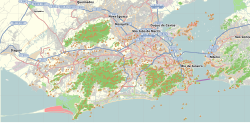Campo Grande (Rio de Janeiro)
| Campo Grande | |
|---|---|
| Neighborhood | |
| Location in Rio de Janeiro | |
| Coordinates: 22°52′57″S 43°33′45″W / 22.88250°S 43.56250°WCoordinates: 22°52′57″S 43°33′45″W / 22.88250°S 43.56250°W | |
| Country |
|
| State | Rio de Janeiro (RJ) |
| Municipality/City | Rio de Janeiro |
| Zone | West Zone |
Campo Grande is the largest neighborhood in the West Zone of Rio de Janeiro. Campo Grande has a population of 328,370 inhabitants and an area of 119,1253 sq km (46 sq mi), on both counts Rio's largest. It is situated 50 kilometers (31 miles) away from Downtown Rio.
Campo Grande, which in the early 1940s was considered the "Empire of the Orange", grew along with the settlement of Brazil. The valley, which begins in the Rio da Prata and ends in Cabuçu, was inhabited by Picinguabas and granted by the Portuguese Crown to Barcelos Domingos. In 1673, Domingos built the chapel of Our Lady of the Exile, which later became the parish church of Campo Grande. Near the church was a well also called Our Lady of the Exile, which provided water to the local population.
The region began to grow in 1878 with the inauguration of the Campo Grande railway station, connected to the Estrada de Ferro Central do Brasil (Brazilian Central Railway). It became easier to reach the center of the city quickly, and the region began to develop at a rapid pace.
On October 16, 1895, Campo Grande began tram service. On that day, the Municipal Council gave a concession to a private company, the Companhia de Carros Urbanos (Urban Streetcar Company), to install a line using animal power. The goal was to provide transportation to the railway.
In 1915, the company proposed to the Prefecture of the Federal District the substitution of animal power with 48 km of electrified lines, whose trams would leave from the center of Campo Grande for Pedra de Guaratiba, Ilha, and Rio da Prata. The line remained in service until October 30, 1967, when trams were removed from Campo Grande.
Campo Grande went from being an essentially rural area to an urban one. Next to Realengo, Jacarepaguá, and Santa Cruz, until 1939 Campo Grande was one of the largest producers of oranges, exporting up to 144,577 tons each year.
...
Wikipedia


